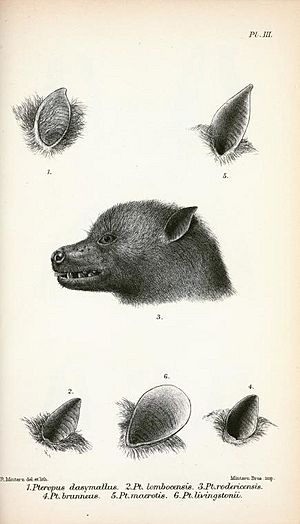Pteropus brunneus facts for kids
Quick facts for kids Pteropus brunneus |
|
|---|---|
| Conservation status | |
| Scientific classification | |
| Genus: |
Pteropus
|
| Species: |
brunneus
|
The Pteropus brunneus was a type of flying fox, which is a large bat. It belonged to the Pteropodidae family. Scientists believe it lived on Percy Island, which is southeast of Mackay, Queensland in Australia. Sadly, this flying fox is now extinct. It was last seen around 1874.
Contents
About the Dusky Flying Fox
The Pteropus brunneus is also known as the Dusky Flying Fox. It was a smaller type of flying fox. Scientists think it weighed about 200 grams (7 ounces). Its head and body together were about 210 millimeters (8.3 inches) long. The fur on its body was a golden-brown color.
What it Looked Like
The first time this bat was described, people noticed its ears. They were smooth and did not have much hair. The skin between its back legs, called the uropatagium, was narrow and covered by fur.
The fur on its neck was longer than on other parts of its body. Most of its fur was short. Its legs were almost completely covered with hair. This bat did not look like other flying foxes found in Australia.
Discovery and History
Scientists only know about the Pteropus brunneus from one single male bat. This bat was collected in 1874. It was almost fully grown. This specimen (the collected bat) was sent to the British Museum of Natural History in London, England.
How it was Described
A scientist named George Edward Dobson officially described this new species in 1878. He wrote about it in a book that listed all the bat specimens at the museum. More details about the bat were added in 1912 after it was studied again.
Since 1912, no one has found any more information about this species. The original bat specimen is still at the British Museum. In the late 1900s, scientists looked at the description again. They still agree that it was a unique species. However, some people wonder if the bat might have been a lost member of another known species.
Where it Lived
The exact place where the Pteropus brunneus lived is not completely clear. The only record says it was found on "Percy Island." This island is thought to be part of the Percy Isles, which are a group of islands off the coast of Australia. But the exact island where the bat was collected has never been confirmed.
Why its Home is a Mystery
The bat was collected by someone who liked to gather specimens. Many people from Britain would collect animals and plants to send back to England.
After this bat was collected, there were reports of a group of bats on the island. But no one ever found any physical proof of them. Later searches have not found any similar large bat groups there.
Scientists have a few ideas about why this flying fox disappeared or why its location is uncertain:
- A group of these bats might have been blown to the islands by a cyclone. They might have died out soon after.
- The person who collected the bat might have made a mistake about where they found it.
Finding old bones or discovering other groups of these bats nearby could help confirm where they truly lived.
See also
 In Spanish: Pteropus brunneus para niños
In Spanish: Pteropus brunneus para niños



